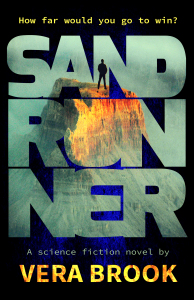

Synopsis
Sand Runner is Vera Brook’s debut novel and follows the story of Kai, a teenage boy growing up in a dystopian future where the world of athletics has taken a dark turn. In Brook’s futuristic landscape, 3D printing is used to create virtually everything, including houses and food. Her novel paints an amplified picture of our throw-away society and feels like a warning for our not too distant future.
In Kai’s world, it has become a social faux pas to talk about repairing anything. If something breaks, don’t fix it, print a new one! That includes body parts. For the right price, 3D printing can give you upgrades on everything, including your face, your hands—your feet.
Enter the athletes. The Olympics are long forgotten. It’s all about the No Limits Race. Sponsors seek out athletic talent and offer them a chance to compete in a 10-day race through various environments, designed to take the runners to the extreme. Here’s the rub: every participant must go through “modifications” in the form of bionic surgeries, turning them into cyborg super-humans. So, it’s no surprise that the sponsors all work for 3D printing companies. In the Race, everyone has an ulterior motive.
Marketed as a YA dystopian sci-fi, Sand Runner should appeal to fans of books like The Hunger Games and Uglies.
Review
Vera Brook’s story is easy to read and well-written. Its style of writing follows suit with other contemporary YA novels. The language gets straight to the point. There’s plenty of action from the beginning, and the pace kicks into high gear when the Race begins. Brook introduces us to a solid male lead in Kai. He has his flaws, his inflated ego being one of them, but it’s probably his obsession with the most popular girl in town that makes him more believable. YA novels often feature awkward, social outcasts as their heroes. So, it’s refreshing to read about an average teenage boy who is confident, surrounds himself with plenty of friends, and is ruled by testosterone more than anything.
However, Brook’s characters lack depth. There are occasions when her attention to pacing wins over character development; therefore, the reader loses out on spending more quality time with the heroes, Kai and Emily. Perhaps it’s because there are too many points of view: the Runner, the Agent, the Sponsor, the Reporter and the Printmaker, and the narrative is spread too thin. So, the enrichment of Kai and Emily, as well as their romance, fall short of what they deserve.
But, on the whole, Brook’s novel is a good read. She takes the time to describe stunning settings in detail (Kai’s desert town, for example) without disrupting the flow of her narrative. And her story, as applies to most of the dystopian variety, serves as a means for social commentary and holds a mirror to our society. That aside, it stands on its own as an engaging novel. It has the makings of a great series, and I’ll probably be purchasing Vera Brook’s next adventure.



![By Charlie N. Holmberg The Paper Magician (The Paper Magician Series) [Paperback] - Charlie N. Holmberg](http://booklikes.com/photo/max/50/80/upload/books/1/2/121a0bcc22b34e86890e86def2bc7975.jpg)


![The Complete Cate Tiernan Sweep Series Books 1-15 in Five Volumes [Book of Shadows, Coven, Blood Witch, Dark Magick, Awakening, Spellbound Calling, Changeling, Strife, Seeker, Origins, Eclipse, Reckoning, Full Circle, Night's Child] - C. Tiernan, Cate Tiernan](http://booklikes.com/photo/max/50/80/upload/books/a/7/a761794dd9b3a8cc2e2c0aaaa0c6a704.jpg)